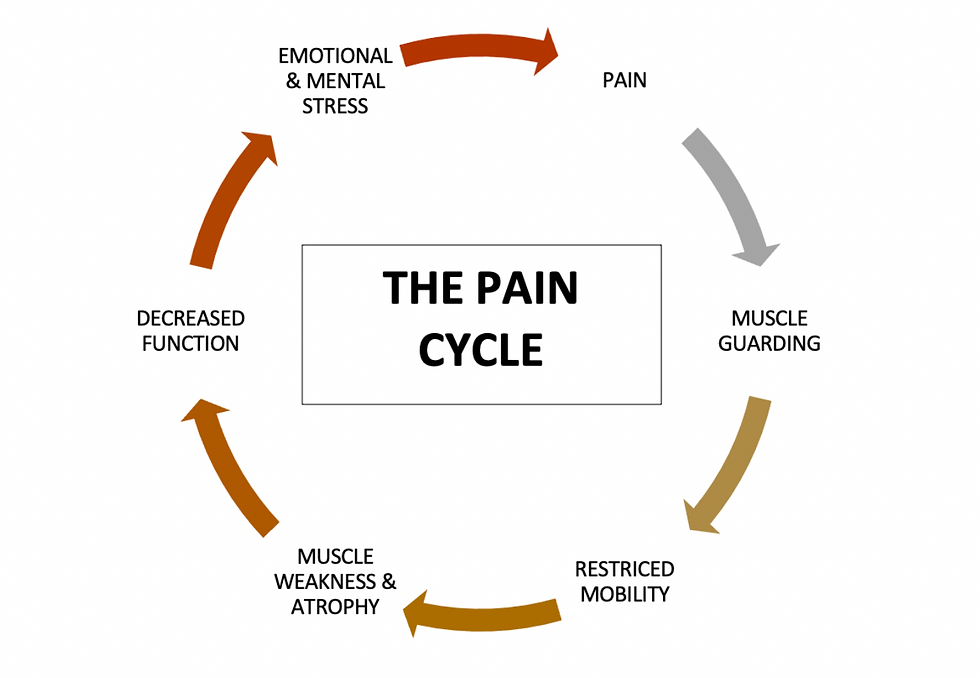WHY DON'T WE MOVE INTO PAIN? - Simplifying the Pain Cycle
- Madi

- Nov 23, 2023
- 3 min read
Updated: Dec 9, 2023
Contrary to common belief, the human body prioritizes survival and efficiency over logic. This means that pain signals can be triggered not only by real threats but also by perceived stress. Escaping the cycle of pain can be difficult, and sometimes you need to take a holistic approach to manage pain effectively and enhance our overall functionality.

The pain cycle includes sense, emotion, and thought. Image via https://drmartinschmaltz.com/
I want you to imagine if you had to spend time with a person who constantly lost their temper and raised their voice. This would trigger the limbic brain, and at some point, you may stop listening or avoid them altogether. You may figure out how to navigate this, but realistically, if this behaviour isn't actually healed; the aggression may just shift somewhere else. Even if the yelling stopped, you would remember the behaviour of the past and come to expect it. Scientifically, it would take 12 positive interactions in which you weren't attacked to 1 negative, for you to not continually expect and prepare for a negative experience.
How does functional pain work?
Functional pain is a type of pain that happens when our body's warning system is activated. It's like a signal telling us that something is wrong and needs attention. Unlike other types of pain, in functional pain, our body both sends and receives the distress signal, which can be confusing to understand.
If we ignore these warning signals and keep going despite the pain without fixing the root cause, we may develop sensory-motor amnesia. This means our body "forgets" how to move correctly, leading to compensatory movements that can make the pain worse. The pain might move from one area to another, creating a cycle of discomfort and distress.
If we keep ignoring our body's signals, the pain can become a long-term issue. What started as mild discomfort can turn into severe, widespread pain that makes it hard to identify the source. This mysterious aspect of functional pain complicates the relationship between our mind and body, emphasizing the importance of listening to our body's messages.
We need to rebuild trust in our bodies

In the somatics class, it is crucial to approach movements with mindfulness and care. The emphasis is placed on listening to your body and never pushing into or through pain. Instead, when faced with discomfort, it is recommended to pause and adjust the movements by making them smaller or even visualizing them in your mind. This gentle approach aims to re-educate our pain system, signaling to our bodies that we are attentive and that it is safe to alleviate the distress signals.
For individuals who have been enduring persistent stress and pain over an extended period, the process of rebalancing the body out of a state of chronic fight or flight response, known as sympathetic overload, requires patience and time. It is essential to acknowledge that healing and restoring balance do not happen overnight but rather through consistent practice and awareness.
Furthermore, part of this healing process involves refraining from pushing through pain and avoiding negative self-talk that can be abusive or self-critical. Instead, cultivating self-compassion and kindness towards oneself is encouraged. Additionally, identifying and modifying environments that trigger stress responses is crucial in creating a supportive and nurturing space for healing and growth.
By adopting these mindful practices and making conscious choices to prioritize self-care and well-being, individuals can gradually transform their relationship with pain, stress, and their bodies, fostering a sense of safety, trust, and resilience.
Where you feel pain, is not necessarily the origin
Functional pain can often feel like a mystery, but somatic education offers a solution. Sensory-Motor Amnesia, a condition impacting pain signals in the body, can create a web of discomfort. Surprisingly, relaxing your side waist can alleviate lower back pain, showcasing the interconnectedness of the body. Stress exacerbates pain by signalling discomfort. To address this issue, somatic movement practices gently engage and release muscles, enhancing the mind-body connection and alleviating pain.
This is why it's important to integrate a somatic movement routine that gently activates the muscles and relaxes them progressively.
This is why we don't moving into pain.



Comments